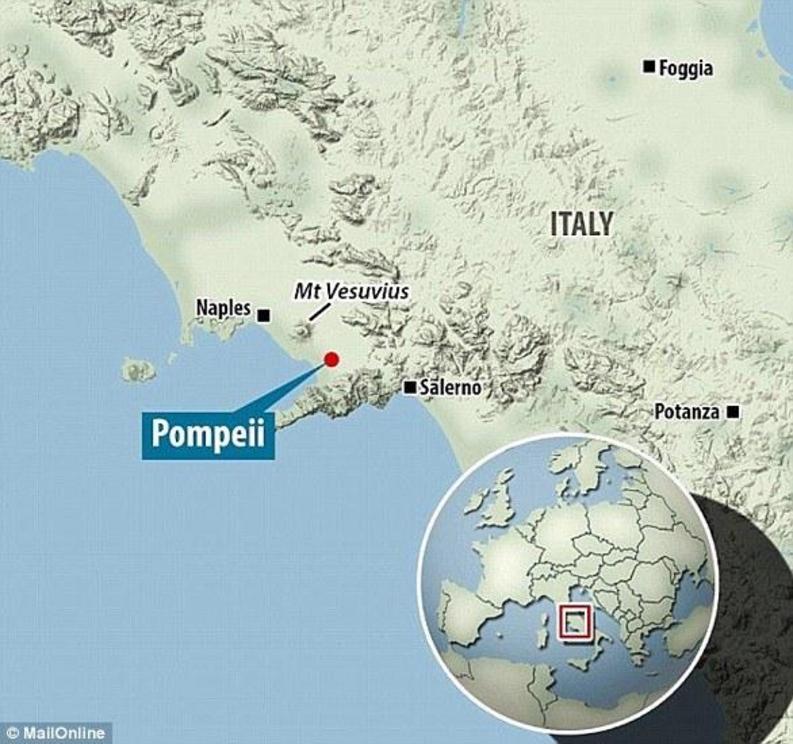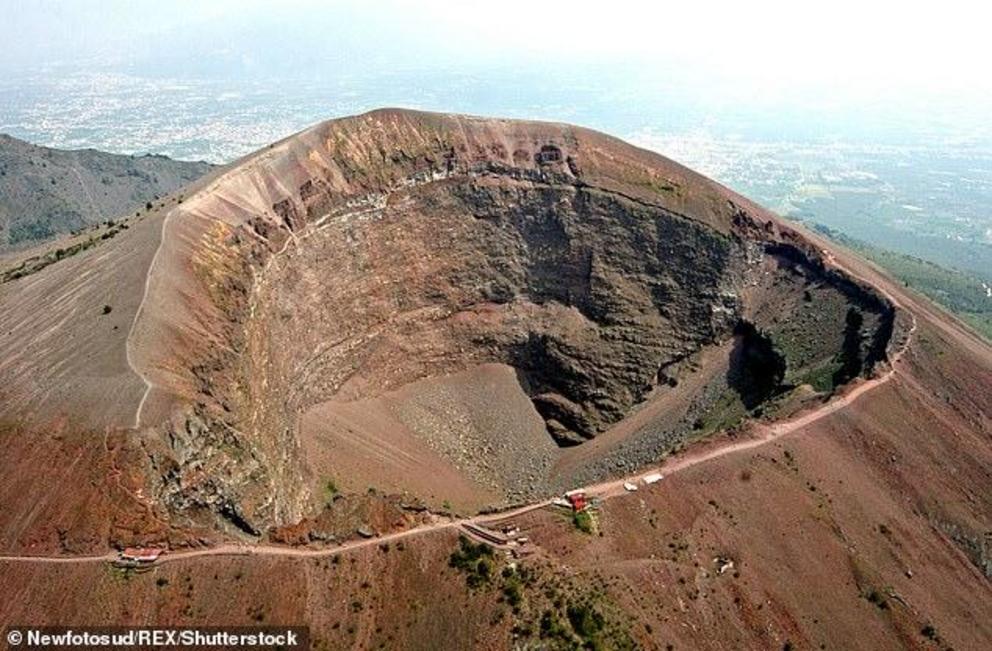Pompeii city officials reveal they are working on a new evacuation plan as seismic activity raises fears of another eruption
Almost 2,000 years after the eruption that killed thousands in Pompeii, city officials have begun putting together a new evacuation plan in case Mount Vesuvius erupts again.
The new plans are being drawn up after a recent increase in seismic activity raised fears of a second eruption in the area.
It would see residents evacuated to Sardinia by boat.
Pietro Amitrano, the mayor of Pompeii, said he was in talks with Sardinia's civil protection authorities about a possible evacuation procedure, according to The Guardian.
'We will start a detailed census of our population first and then discuss in which town in Sardinia our citizens will be transferred, hoping that this day will never come,' he said.
The area around Vesuvius is populated by 3 million people, making it the most densely populated volcanic region in the world.
Last month Flavio Dobran, one of the leading experts on Vesuvius, warned that without a security plan, an eruption could kill thousands of people.
Dr Pete Rowley from the University of Portsmouth, recently told The Independent
'Vesuvius is a really rather active volcano.
'It's famed for its eruption that wiped out Pompeii and Herculaneum, but it's had something like 50 eruptions since then. With Naples next door it poses a quite substantial risk to the local population, so is carefully monitored.'

A painting depicts the eruption of Mount Vesuvius near modern-day Naples 2,000 years ago
The eruption of Mount Vesuvius 2,000 years ago may have killed people by blowing up their heads, a recent study of ancient skulls shows.
Material that poured from the volcano was so hot that it vaporised people's blood, quickly turning it into steam.
It also boiled people's brains, building up steam pressure in their heads until they exploded, according to a new analysis of remains found at Herculaneum - one of the closest cities to the 79 AD eruption.
The blast near modern day Naples is thought to have killed 16,000 people and buried Herculaneum and neighbouring town Pompeii in rock and deadly hot ash.
Researchers are also increasingly concerned about Campi Flegrei, a volcanic caldera to the west of Naples that last erupted centuries ago.

Campi Flegrei's caldera (pictured) is found about nine miles to the west of Naples and is one of the few active supervolcanoes in the world. It has not erupted since 1538 but is capable of creating a 'super-colossal' eruption
The supervolcano in southern Italy is building huge magma reserves as it prepares to erupt at 'some undetermined point in the future', scientists say.
The vast Campi Flegrei volcano is made up of 24 craters and scientists have found it is accumulating the magma as part of a transition into a 'pre-eruption' phase.
Experts have said that an eruption is not expected in the imminent future but the volcano has shown signs of significant unrest over the last 60 years.
When the volcano eventually erupts it is likely to be comparable in size to the eruption of Mount Vesuvius that destroyed the cities of Pompeii and Herculaneum.
WHAT DO WE KNOW ABOUT VESUVIUS AND THE DESTRUCTION OF POMPEII?
What happened?
Mount Vesuvius erupted in the year AD 79, burying the cities of Pompeii, Oplontis, and Stabiae under ashes and rock fragments, and the city of Herculaneum under a mudflow.
Mount Vesuvius, on the west coast of Italy, is the only active volcano in continental Europe and is thought to be one of the most dangerous volcanoes in the world.
Every single resident died instantly when the southern Italian town was hit by a 500°C pyroclastic hot surge.
Pyroclastic flows are a dense collection of hot gas and volcanic materials that flow down the side of an erupting volcano at high speed.
They are more dangerous than lava because they travel faster, at speeds of around 450mph (700 km/h), and at temperatures of 1,000°C.
An administrator and poet called Pliny the younger watched the disaster unfold from a distance.
Letters describing what he saw were found in the 16th century.
His writing suggests that the eruption caught the residents of Pompeii unaware.

Mount Vesuvius erupted in the year AD 79, burying the cities of Pompeii, Oplontis, and Stabiae under ashes and rock fragments, and the city of Herculaneum under a mudflow
He said that a column of smoke 'like an umbrella pine' rose from the volcano and made the towns around it as black as night.
People ran for their lives with torches, screaming and some wept as rain of ash and pumice fell for several hours.
While the eruption lasted for around 24 hours, the first pyroclastic surges began at midnight, causing the volcano's column to collapse.
An avalanche of hot ash, rock and poisonous gas rushed down the side of the volcano at 124mph (199kph), burying victims and remnants of everyday life.
Hundreds of refugees sheltering in the vaulted arcades at the seaside in Herculaneum, clutching their jewellery and money, were killed instantly.

The Orto dei fuggiaschi (The garden of the Fugitives) shows the 13 bodies of victims who were buried by the ashes as they attempted to flee Pompeii during the 79 AD eruption of the Vesuvius volcano
As people fled Pompeii or hid in their homes, their bodies were covered by blankets of the surge.
While Pliny did not estimate how many people died, the event was said to be 'exceptional' and the number of deaths is thought to exceed 10,000.
What have they found?
This event ended the life of the cities but at the same time preserved them until rediscovery by archaeologists nearly 1700 years later.
The excavation of Pompeii, the industrial hub of the region and Herculaneum, a small beach resort, has given unparalleled insight into Roman life.
Archaeologists are continually uncovering more from the ash-covered city.
In May archaeologists uncovered an alleyway of grand houses, with balconies left mostly intact and still in their original hues.

A plaster cast of a dog, from the House of Orpheus, Pompeii, AD 79. Around 30,000 people are believed to have died in the chaos, with bodies still being discovered to this day
Some of the balconies even had amphorae - the conical-shaped terra cotta vases that were used to hold wine and oil in ancient Roman times.
The discovery has been hailed as a 'complete novelty' - and the Italian Culture Ministry hopes they can be restored and opened to the public.
Upper stores have seldom been found among the ruins of the ancient town, which was destroyed by an eruption of Vesuvius volcano and buried under up to six metres of ash and volcanic rubble.
Around 30,000 people are believed to have died in the chaos, with bodies still being discovered to this day.
Video can be accessed at source link below.

